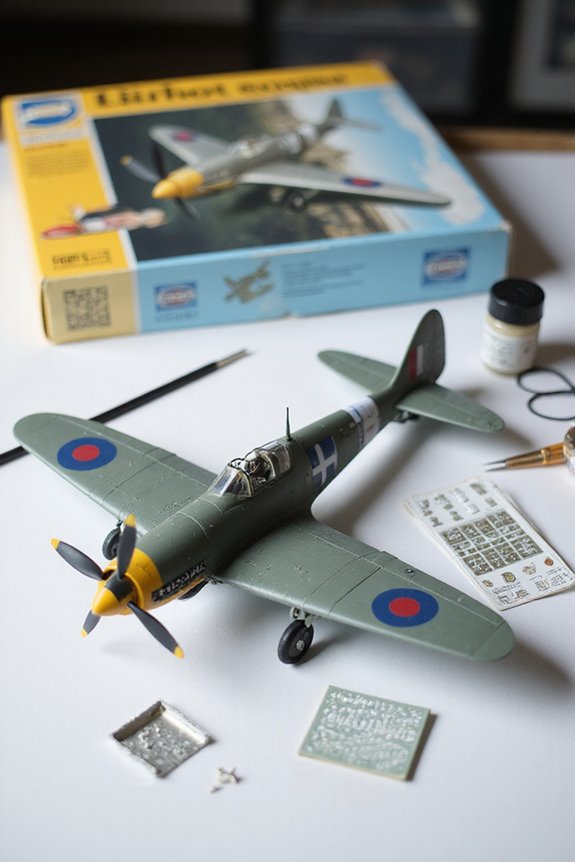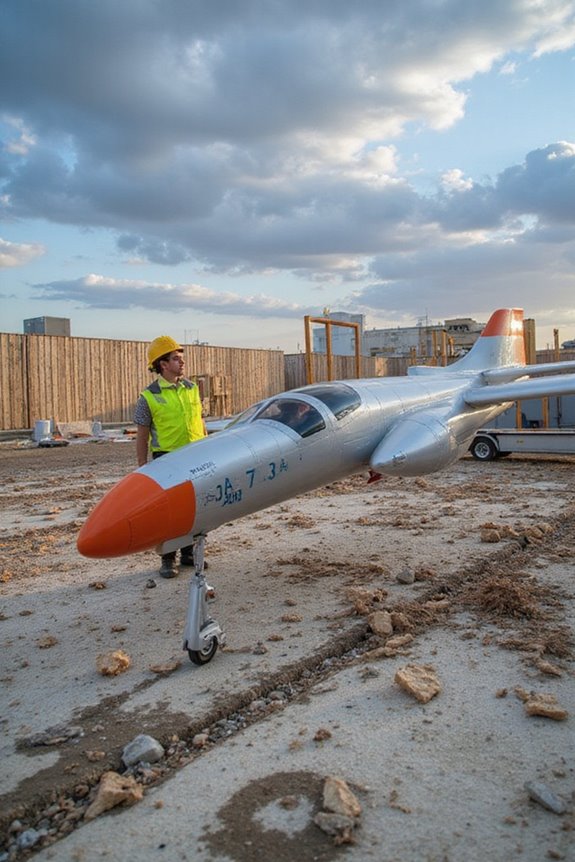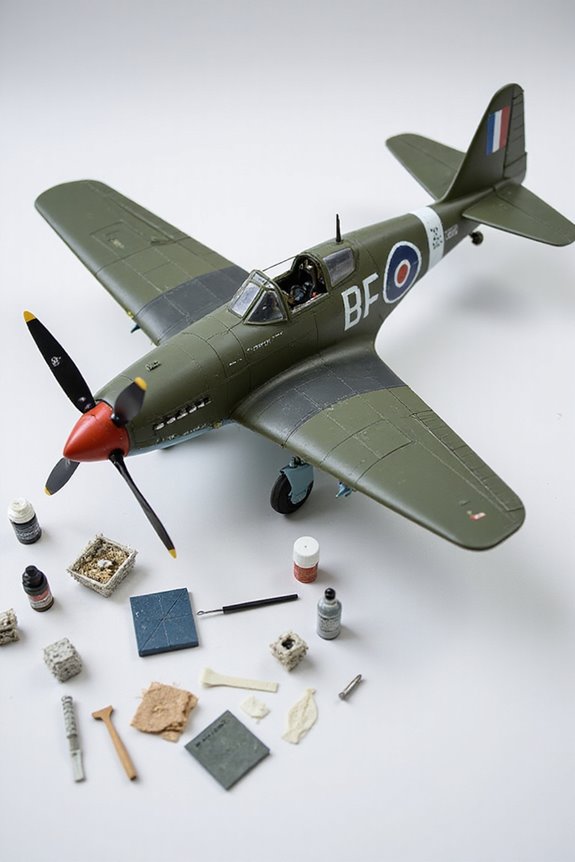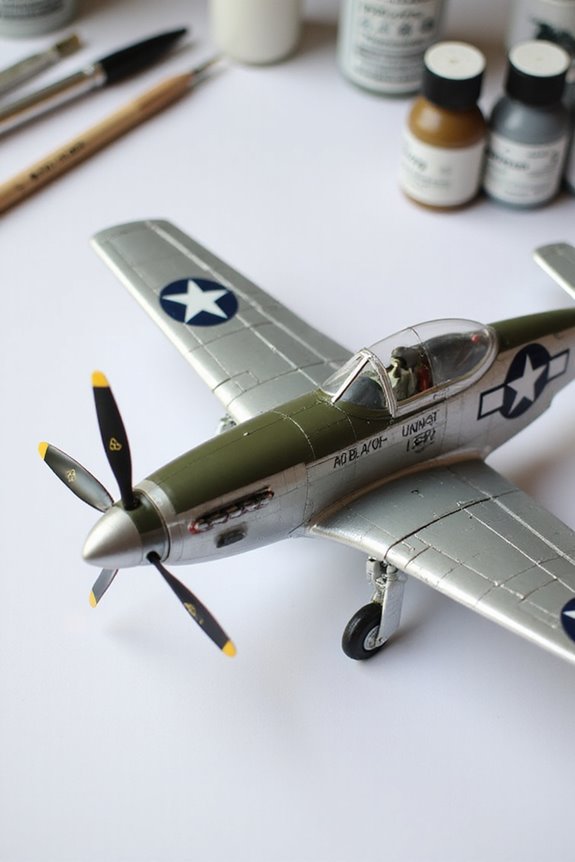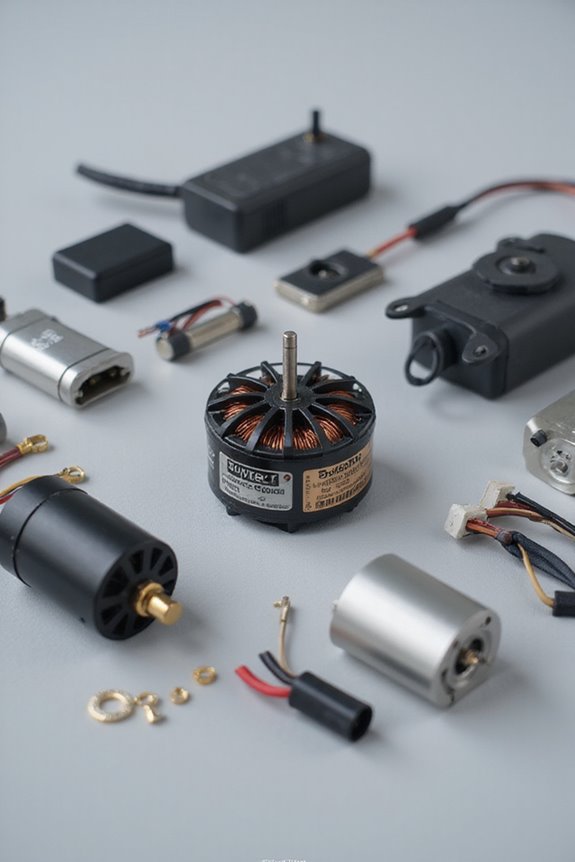To compare prices for model aircraft kits, we should start by exploring various platforms like eBay, HobbyLink Japan, and Lucky Model. We need to check kit types too—styrene’s budget-friendly, while resin kits cater to detail lovers. Don’t forget to assess what’s included; no one wants missing wings! We should also consider brand reputation and model popularity. With the right approach, we can score fantastic deals and avoid those pesky budget-busters. Curious about more tips?
Key Takeaways
- Set price alerts on platforms like eBay to track fluctuations in model aircraft kit prices effectively.
- Use retailer comparison tools on websites like HobbyLink Japan and Lucky Model for competitive pricing.
- Filter options by brand and price on dedicated model sites to simplify your search for the best deals.
- Read online reviews to gauge kit quality and avoid potential disappointments during your purchase.
- Evaluate the completeness of kits and included accessories to ensure fair pricing relative to value.
Understand Kit Types and Quality Levels
When diving into the world of model aircraft kits, understanding the different types is key to picking the right one for us. There are styrene injection molds, which are cost-effective and durable. They’re the bread and butter of the hobby. Then we’ve got resin kits, which are pricier but fun for detail lovers. If we’re feeling adventurous, vacuum forming kits require skill—like a puzzle that challenges our wits!
Let’s not forget about paper kits, perfect for newbies, and fiberglass or carbon fiber kits for us seasoned pros wanting durability. Each type varies in assembly difficulty too; from simple snap-together models to intricate builds that require time and patience. Choosing the right kit materials sets the stage for our creative journey! Additionally, it’s important to consider the educational benefits of building models, as they enhance critical thinking and problem-solving skills.
Source Prices Across Multiple Platforms

How can we find the best prices for our favorite model aircraft kits? It’s all about sourcing prices across multiple platforms! First, let’s explore price tracking; it’s essential for snagging the best deals. We can set alerts on sites like eBay or use tools from retailers to keep tabs on price drops.
Next, let’s hit up retailers like HobbyLink Japan and Lucky Model. They often have competitive pricing and sweet shipping rates. Don’t forget to check online reviews before buying—those insights can save us from unforeseen disappointments! By filtering options by brand and price on sites like ModelCars.com, we can pinpoint exactly what we need, making comparisons a breeze. Happy hunting, fellow modelers!
Evaluate Kit Completeness and Included Accessories
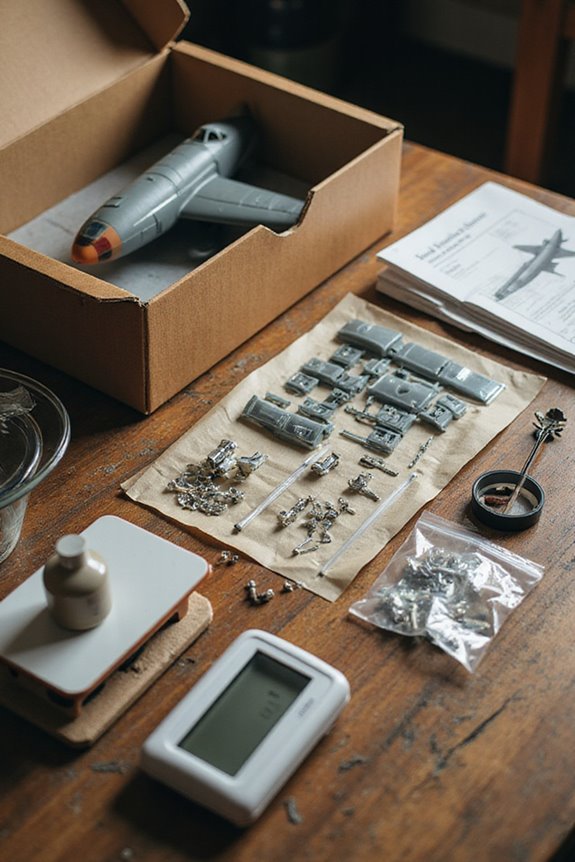
After hunting down the best prices online, we need to make sure those model aircraft kits we’re eyeing are complete and ready for action. Let’s start with kit integrity; we must check that structural parts like wings, fuselage, and stabilizers are all included. We should also verify accessory verification for hardware like screws and hinges, which are crucial for assembly.
Don’t forget to look for any electronic components, like receivers or batteries, along with other essential parts like propellers. A thorough inspection of the packaging can save us from the headaches of missing bits and pieces. We want our aircraft to soar, not crash into the “incomplete kit” zone! Additionally, ensuring that the kit matches your skill level requirements can enhance your overall building experience.
Consider Brand Reputation and Model Popularity
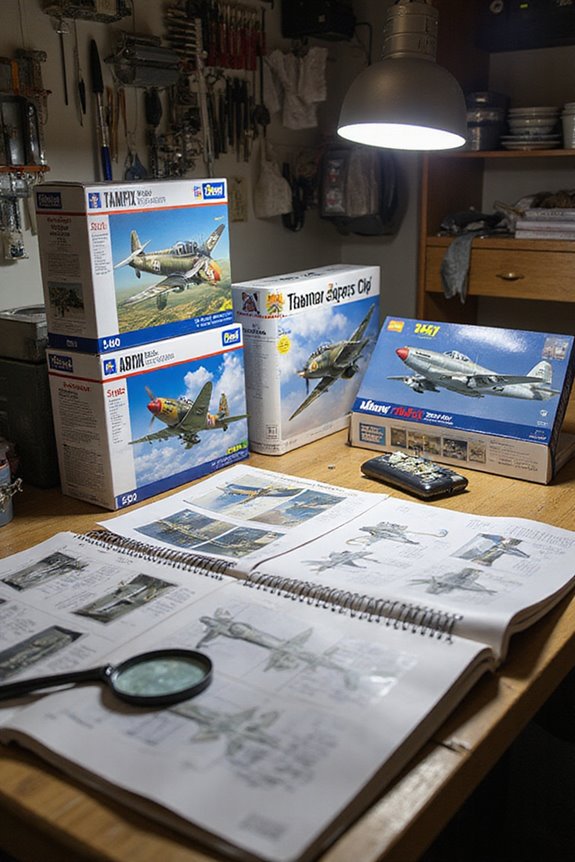
Though it might seem inconsequential, brand reputation plays a huge role in our model aircraft kit shopping spree. When we see a kit from brands like Tamiya or Eduard, we’re often willing to pay a bit more. Their consistent quality and premium features foster brand loyalty and trust. On the flip side, older brands like Airfix might steer us away due to their inconsistent reviews.
Additionally, model popularity shapes price dynamics. Well-known aircraft kits—like a B747—typically carry higher price tags due to demand. We should pay attention to market trends too. Limited editions capitalize on buzz, inflating prices while niche brands may offer less-recognized models at lower costs. Balancing quality, popularity, and brand reputation makes for a savvy purchase! Moreover, considering educational benefits of model airplane kits can also influence your decision, as these kits offer more than just assembly; they provide valuable learning experiences.
Analyze Pricing Relative to Scale and Build Complexity
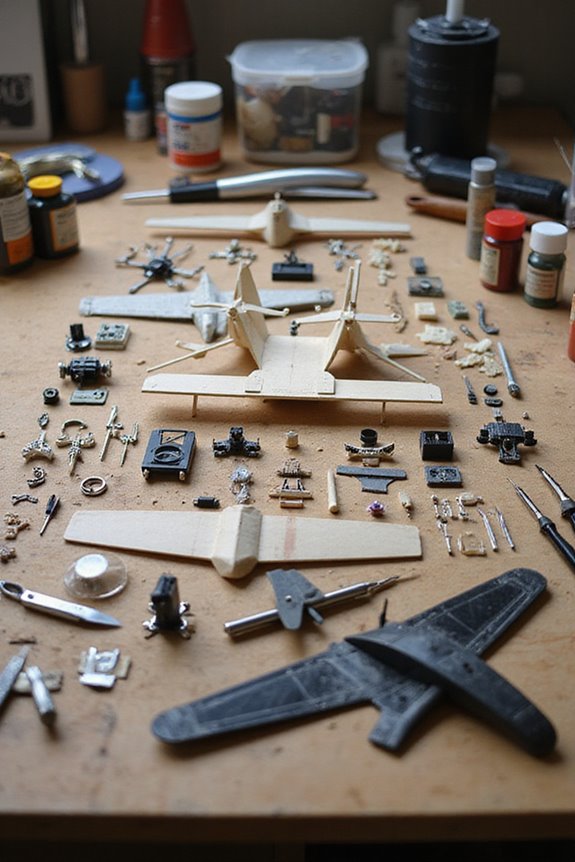
When we plunge into the world of model aircraft kits, the relationship between scale and build complexity can’t be overlooked. The scale impact on pricing is evident: smaller scales like 1/72 are easier on the wallet. They balance affordability with decent detail. On the flip side, larger scales, such as 1/32, offer exquisite detailing but come with heftier price tags due to complexity factors like intricate parts and larger molds.
Plus, let’s be real—who’s got the display space for a gigantic 1/32 model? It’s a big commitment! So, when hunting for kits, consider the joy of your workspace. We want our models to shine, not become space hogs. In modeling, it’s all about finding that sweet spot! Additionally, choosing a kit with material quality considerations can significantly influence both the assembly experience and the final appearance of your model.
Use Indexed Pricing and Historical Comparisons
While wading through the waters of model aircraft pricing, we should take a moment to contemplate indexed pricing and historical comparisons. Tracking price trends is like steering a radar — it helps us spot patterns amidst the fog of fluctuations.
Indexed pricing looks at how prices change over time, adjusting for inflation. By establishing a baseline, we can compare today’s prices to those from yesteryear. This isn’t just about numbers; it involves understanding component costs and market demand.
Using tools like the Consumer Price Index (CPI) can provide context. Did costs soar because of new materials? Or was it just a seasonal blip? With clear, historical comparisons, we’re not just flying blind. We’re equipped to make informed decisions about our next favorite kit. Additionally, knowing the complexity and skill level of different models can influence pricing and the value you get from your purchase.
Identify Seasonal Sales and Discounts
After understanding how prices fluctuate through indexed pricing, it’s time to look out for seasonal sales and discounts that can lighten our wallets. Holiday promotions, like those around Christmas, can bring some incredible deals on model kits. Trust us; it’s a perfect time to stock up!
Many stores, like Michaels and Hobby Lobby, offer coupon usage throughout the year. Signing up for newsletters gives us early access to special discounts. Don’t forget end-of-year clearance events; they often help retailers clear space, resulting in great savings on those model kits we’ve had our eyes on.
And if we’re feeling adventurous, yard sales and model shows might surprise us with unexpected finds. It’s all about timing and a little luck!
Assess Shipping Costs and Availability
So, how do we tackle shipping costs without breaking the bank? First, we need to evaluate shipping transparency. Some retailers hide those pesky fees until checkout, making our wallets quiver. Typically, shipping costs for model kits range from $8 to $9, which can skyrocket if we’re not careful—shipping might even outpace the kit’s price!
We should also keep an eye on cost factors like package size and distance. Bulk ordering can slash per-kit shipping, if allowed. And beware of international shipping; customs can add all sorts of surprises. Finally, check if retailers offer free shipping over certain amounts—like MegaHobby at $100. It might just be the key to scoring our dream kit without a financial hangover!
Frequently Asked Questions
How Do I Know if a Kit Is Worth the Price?
To determine a kit’s worth, we should conduct a value assessment by comparing features, quality, and available options. A thorough price comparison, considering personal interest and rarity, will guide our decision on value.
What Are the Common Materials Used in Model Kits?
We’re often intrigued by model kits, aren’t we? From balsa and foam to various plastic types, each offers unique assembly techniques. Let’s explore how these materials shape our creations and influence our building experiences together.
How Can I Find Reviews for Specific Model Kits?
We can find reviews for specific model kits by exploring online forums and reading expert reviews. These resources offer valuable insights, helping us make informed choices about our next modeling project. Let’s plunge in together!
Are There Any Warranties for Model Aircraft Kits?
When steering through the skies of model aircraft kits, we’ll discover warranty coverage can be a lifesaver. Customer support varies, so let’s verify we thoroughly review those warranty details before making our next purchase!
What Tools Do I Need for Assembling Model Kits?
When assembling model kits, we need essential tools like a precision hobby knife, tweezers, and fine sandpaper. Mastering building techniques is vital too, ensuring our models look impressive when completed and displayed.

